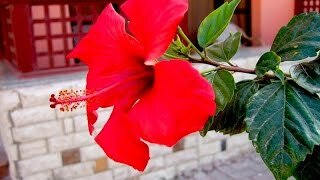Hibiscus room refers to the malvian family of representatives of the flora. In natural conditions, it grows in Western India, China, as well as the African tropics. There, this plant is used to decorate wedding ceremonies. And there are special varieties of hibiscus, which are used for making fragrant and unusually tasty tea. They not only quench their thirst, but also cure all kinds of ailments. In food, seeds and fruits of hibiscus are used, and also used for canning to achieve a beautiful pink color of the syrup.
This representative of the world of flora has a lot of admirers. Therefore, hibiscus has long since moved from the southern gardens to the apartments, because it is almost not whimsical and willingly blooms with minimal care. A flower hibiscus simply unique in its beauty.
Varieties of hibiscus
There are several varieties of plants. It does not make sense to list everything, but the most popular of them is worth mentioning.
-
Hibiscus herbaceous.
Such a variety has erect powerful trunks. Their height is - a maximum of 2.5 m. And although this hibiscus has fewer leaves and flowers than its counterparts, but their size is much larger. Colors range from white to red. This plant is frost-hardy, but loves sunny places. True, it will grow not only in very sunny areas, but also in partial shade. Therefore, it can be planted in autumn and spring. In any case, hibiscus will perfectly get accustomed. Only a young plant should be immediately prishepit. So the bush will give lateral shoots and become more magnificent. This is very important, because the larger the hibiscus, the more flowers it blossoms at the same time.
-
Hibiscus is a garden or Syrian hibiscus.
This variety is characterized by the magnificence of flowers, which are distinguished by a wide range of shades: white, pink, red, purple and soft blue. Some subspecies in the pharynx of the flower also have a dark speck, which only accentuates the exoticity of hibiscus. The golden stamens give a special charm to the flowers, which grow together into a long tube that extends far from the petals. Garden hibiscus is adapted for growing on open land, because it has sufficient frost resistance. He is very fond of landscape designers who plant hibiscus in the most prominent places: at the entrance to the house, at the center of the flower garden, etc. Since this shrub is too short( 1-1.5 m in height), it fits perfectly into the interior of the terrace or garden on the balcony. Hibiscus garden is good because it blooms from July to September inclusive. Usually it is supplemented by such "neighbors" as lavender and ground-covering roses.
-
Hibiscus Chinese.
This is a beautiful and very common indoor plant. And although it is an evergreen shrub, but often more like a relatively tall tree, which has oval, bright green leaves with denticles at the edges. Hibiscus "Chinese rose" can have double or double flowers, with cicatricial petals. Their size reaches 15 cm in diameter. The color of the Chinese rose is quite rich: red, pink, orange, yellow, white. And although delicate and delicate petals of flowers last only one day, but new flowers bloom one after another every day and it lasts a whole summer. But in the room, Chinese hibiscus is difficult to grow because it needs a lot of space.
Hibiscus: home care
Since this plant comes from the tropics, it must be kept in conditions that are as close to tropical as possible.
- Lighting .Hibiscus is very light-loving. Of course, he will not die in conditions of insufficient illumination, but at the same time do not expect a rich flowering. Sometimes it may not be at all. Therefore, it is better to plant on a sunny window sill, shading from the hot midday sun.
- Watering .Watering hibiscus should be abundant, if the outdoors is summer or spring. But in the winter, go to a moderate watering, controlling that the earth clod is not too dry. The leaves can be sprayed. Especially the need for this increases if there is insufficient humidity in the room.
- Temperature of .Adhere to a moderate temperature regime, so that there are no sharp fluctuations. But in winter the critical minimum is +12 degrees.
During growth and flowering, hibiscus should be fed once a week by organic and mineral fertilizers alternately. - fertilization with fertilizers .When hibiscus actively grows and blooms, once a week feed it with mineral and organic fertilizers, observing the order of succession.
- Transplant .Before 5-6 years of age, hibiscus should be transplanted every year. An adult plant will only need one transplant every 3-4 years. The appearance of such a need is evidenced by the roots that weave all over the earth. Transplant hibiscus is better in the early winter. You will need a nutritious land, which consists of leaf, humus and clayey-turf earth( 1: 1: 2).When transplanting part of the roots can be cut to activate the growth of young shoots. This will also have a general positive effect on hibiscus. Reproduction by cuttings will allow you to decorate a given plant with a large area.
- Growth problems of .Hibiscus is quite hardy, but if you make any mistakes in care, the buds will begin to fall off, and the leaves will wrinkle. As for diseases and pests, hibiscus often suffers from spider mites and aphids. With them you need to fight with special medications.
Hibiscus: useful properties and contraindications
This plant has a huge amount of polysaccharides - these are natural immunomodulators that protect the body from the harmful effects of certain microorganisms. In addition, hibiscus is rich in fruit acids( wine, apple, lemon), vitamin C, flavonoids and other substances. Tea made from this plant is allowed even for those suffering from kidney diseases, since there is no oxalic acid in hibiscus.
Hibiscus has practically no contraindications. The main thing - do not boil it for a long time, so that the tea does not get an unpleasant shade. And it is not recommended to give such a drink to children up to one year. Hypertensive tea from hibiscus should be used in moderation, so that they do not worsen urine and cholelithiasis.
Related Videos:
 8:34
8:34  8:36
8:36  9:16
9:16 